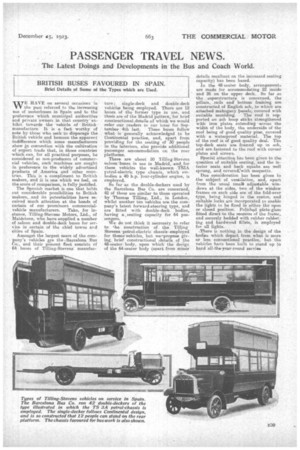• PASSENGER TRAVEL NEWS.
Page 21

If you've noticed an error in this article please click here to report it so we can fix it.
The Latest Doings and Developments in the Bus and Coach World.
BRITISH BUSES FAVOURED IN SPAIN.
Brief Details of Some of the Types which are Used.
WE HAVE on several occasions in :the past referred to the increasing use of motorbuses in Spain and to the preference which municipal authorities and private owners in that ceuntry"exhibit towards the vehicle of British inanufactura It is a fact worthy of note by those who seek to disparage the British vehicle and bemoan -the apparent indifference which some manufacturers show 4:_n connection with the cultivation of exporttrade that, in &nee countries which can, for all practical purposes, he considered as non-producers of commercial vehicles, such machines are sought in preference to the widely advertised products of America and other countries. This is a compliment to British makers, and it is one which we feel, on the score of comparieon, is fully justified.
The Spanish market is one that holds cut considerable possibilities to British makers, and its potentialities have received much attention at the hands of certain of our prominent commercial
vehicle manufacturers. Take, for instance, Tilling-Stevens Motors, Ltd., of Maidstone, who have supplied a number of saloon and double-deck buses for ser. Aire in certain of the chief towns and cities of Spain.
Amongst the largest risers of the company's vehicles al-e the ;Barcelona Bus ., and their present fleet consists ef 64 buses of Tilling-Stevens manufac
ture; single-deck and double-deck vehicles being employed. There are 12 buses of the former type in use, and thee are of the Madrid pattern, for brief constructional.details of which we would refer our readers to our issue for Sep tember 4th last. These buses follow what is generally acknowledged to be Continental practice, and, apart from providing for the seating of 30 people in the interiors, also provide additional passenger accommodation on the rear platforms There are about 50 Tilling-Stevens saloon:buses in use in Madrid, and for these vehicles the Well-known It3A retroI-electric type chassis, which embodies a 40 h.p. four-cylinder engine, is employed.
So far as the deuhle-deckers used by the Barcelona Bus Co. are concerned, 42 of these are similar to those operated by Thomas Tilling, Ltd., in London, Whilst another ten vehicles are the company's latest forward-steering type, and are fitted with double-deck bodies, having a ,seating capacity for 64 passengers.
We do not think it necessary to refer to '-he construction of the Tilling Stevens 'petrol-electric ,chassis,emplOyed for theseivellicles, but, werprepose giving, brief constructional ,details of the 48-seater body, upon which' the design of the 64-seater body (apart from-Minor
details resultant on the increased seating capacity) has been based.
In the 42-seater body, arrangementare made for accommodating 22 inside and 26 on the upper deck. So far as the superstructure is concerned, the pillars, rails and bottom framing are constructed of English ash, to which are attached mahogany panels, covered with
suitable moulding. The roof is supported on zi ah hoop eticks strengthened with iron plates extending across the width of the body, the underside of the roof being of-good quality pine, covered with a waterproof material. The top, of the roof is of good quality deal. The top-deck seats are framed up in ash, and are fastened to the roof with corner plates and screws,
Special attention has been given to tho question of suitable seating, and the interior seats and back squabs awe well sprung, and covered:with moquette.
Due consideration has been given to the subject of ventilation, and, apart from the usual smal4 adjustable windows at the sides, two of the window frames on each side are of the fold-over ;type, being hinged in the centre, and suitable locks are incorporated to enable the lights to be fixed in either the open or closed position. Polished plate-glass fitted direct. to the recesses of the frame, and securely bedded with rubber rabbeting' and hardwood fillets, is employed for all lights.
-There is nothing in the design of the bodies which depart from what is more or less conventional practice, but the Vehicles have been built to stand •up to hard all-the-year-round serviee




























